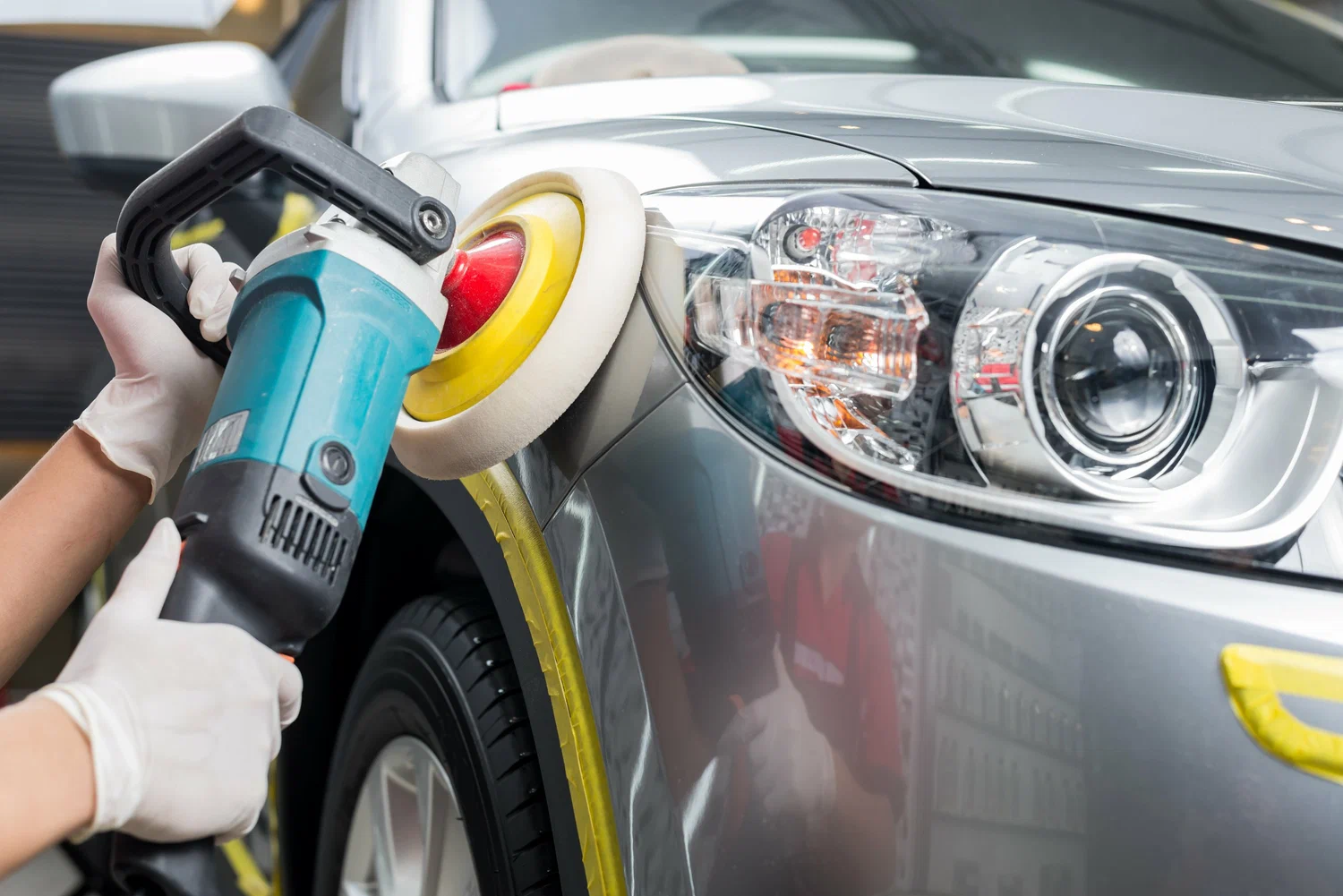What Is Paint Correction and Why Your Car Needs It?
Paint correction is an essential process for vehicle owners who want to restore their car’s paint to its original glory. It is an advanced technique used to remove imperfections such as swirl marks, scratches, water spots, oxidation, and other blemishes from a car’s paintwork. The goal is to improve the vehicle’s appearance by eliminating surface defects, enhancing the depth and clarity of the paint, and providing a smooth and glossy finish.
Paint correction can make a significant difference in the look of your vehicle, whether you are preparing it for resale, showing it off at a car meet, or simply maintaining it to keep it looking like new. If you’re someone who values the aesthetics of your car, understanding what paint correction is and why it is necessary is crucial.
Understanding the Process of Paint Correction
Paint correction is typically performed using a dual-action polisher or rotary polisher, along with various grades of polishing compounds. The process involves several steps to ensure that the paint is restored to its best possible condition. Here’s an overview of how paint correction works:
- Washing and Decontaminating the Car: The first step in the paint correction process is thoroughly washing the car. This is crucial because any dirt, grime, or other contaminants on the surface can scratch the paint when the correction process begins. After washing, it’s important to perform a clay bar treatment. The clay bar helps to remove embedded contaminants, like tree sap, industrial fallout, and other particles that washing alone cannot remove. This ensures the surface is clean and smooth before polishing.
- Inspecting the Paint: Once the car is clean and dry, the paint is inspected to determine the level of correction required. The technician will evaluate the paint’s condition using a combination of visual inspection and artificial lighting. This helps to identify imperfections like swirl marks, scratches, oxidation, water spots, and other defects.
- Polishing: Polishing is the core of the paint correction process. This is done using a machine polisher with different pads and compounds, depending on the severity of the defects. The technician will start with a more abrasive compound to remove deeper scratches or swirl marks and gradually switch to finer compounds to refine the finish and restore the shine. The goal is to level the clear coat without removing too much of the paint. The number of polishing stages may vary, with some vehicles requiring one stage and others needing multiple stages to achieve a perfect finish.
- Finishing: After the paint has been polished, a finishing polish is applied to enhance the clarity and depth of the paint. This step leaves the paint with a mirror-like finish, free from any hazing or swirl marks. It is a critical step to ensure that the final appearance is flawless.
- Protection: Once the correction process is complete, the car’s paint is usually sealed with a layer of wax, sealant, or ceramic coating. This helps to protect the newly corrected paint from environmental contaminants and UV damage. It also provides a glossy, hydrophobic finish that makes it easier to maintain the vehicle’s appearance in the future.
Types of Paint Imperfections That Paint Correction Fixes
Paint correction targets a variety of imperfections that can develop on a vehicle’s paint over time. Some of the most common types of defects that paint correction addresses include:
- Swirl Marks: Swirl marks are fine scratches that appear on the paint, often caused by improper washing or drying techniques. They are circular or spiral-shaped marks that can be very noticeable in direct sunlight. These are one of the most common imperfections corrected through the paint correction process.
- Scratches: Scratches are deeper than swirl marks and can be caused by a range of factors, including brushes, tree branches, or even improperly wiping down the vehicle. Depending on the severity of the scratch, paint correction can help to minimize or even eliminate it.
- Water Spots: Water spots are caused by minerals in water that leave marks on the paint. They typically form after rain or when water is left on the car during drying. Over time, water spots can etch into the paint if not addressed, making them harder to remove. Paint correction can remove water spots and restore the car’s shine.
- Oxidation: Oxidation occurs when the paint reacts with the air and UV rays from the sun, causing the paint to become dull and faded. It is more common in older cars or vehicles with neglected paint jobs. Paint correction can help to restore the paint’s vibrancy and shine by removing the oxidized layer.
- Hazing and Buffer Trails: These imperfections often occur during previous detailing or polishing work when a technician uses an incorrect technique or abrasive products. Hazing refers to a cloudy or dull appearance, while buffer trails are fine, circular lines left behind by the polisher. Both of these can be corrected through paint correction.
- Marring: Marring is the result of fine scratches caused by abrasive materials like towels or sponges. Marring can create an unsightly effect, especially in darker-colored cars, where scratches are more visible. Paint correction removes these imperfections and restores clarity.
Why Your Car Needs Paint Correction
There are several compelling reasons why you should consider getting paint correction for your vehicle, whether it’s new or old. Some of the most significant benefits include:
- Restoring the Appearance of Your Vehicle: One of the most obvious reasons for paint correction is to restore the appearance of your vehicle. Over time, cars are exposed to various environmental contaminants, and minor scratches, swirls, and other imperfections can detract from the car’s beauty. Paint correction can remove these flaws, making the car look shiny and new again.
- Increased Resale Value: If you plan to sell your car, a vehicle with a smooth, glossy finish will typically fetch a higher price than one with visible imperfections. Paint correction improves the car’s aesthetic appeal and can increase its resale value. By restoring the paint, you also show potential buyers that the car has been well-maintained.
- Enhanced Protection: The paint correction process helps to remove contaminants that might otherwise damage the paint over time. This can prevent further deterioration of the clear coat and protect the vehicle from future environmental damage. Additionally, by applying a protective coating like a ceramic coating after the correction, you provide an added layer of protection from contaminants, UV rays, and even light scratches.
- Prolonging the Lifespan of Your Paint: Regular maintenance of your vehicle’s paint, including paint correction, can help extend its life. By removing contaminants and imperfections, you reduce the chances of the paint becoming prematurely damaged or oxidized. A smooth, well-maintained surface is less prone to issues like fading or peeling.
- Improved Shine and Gloss: After paint correction, your vehicle will have a much more vibrant and reflective finish. Swirl marks and scratches can make the paint look dull and lifeless, but once corrected, the paint will have an incredible depth and gloss that enhances the car’s overall appearance.
- Better Protection Against the Elements: Once the paint correction is completed and a protective layer is applied, your vehicle becomes more resistant to elements like water, dirt, bird droppings, and tree sap. This makes future washes and maintenance easier, as contaminants are less likely to adhere to the paint’s surface.
- Prevents Further Damage: Minor imperfections, such as swirl marks and scratches, can accumulate over time. If left untreated, these imperfections can worsen and lead to more significant damage, such as clear coat failure. By addressing these issues early through paint correction, you prevent the problem from getting worse, saving you money on more extensive repairs later.
Conclusion
Paint correction is a highly effective method of rejuvenating your vehicle’s paintwork, restoring its original shine and vibrancy, and protecting it from future damage. Whether your car is new or old, paint correction can make a noticeable difference in its overall appearance. It eliminates imperfections like swirl marks, scratches, water spots, and oxidation, leaving the paint looking flawless and glossy.
For those who care about their car’s aesthetics, paint correction is an investment that not only improves the vehicle’s look but also helps maintain and preserve the paint for years to come. When done properly, it enhances the car’s resale value, provides better protection against environmental elements, and ensures the paint remains in top condition. If your car is suffering from imperfections in its paint, it might be time to consider paint correction as the solution to restore its beauty and protect it for the long term.


